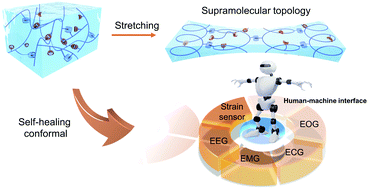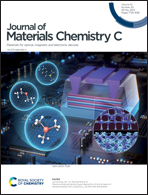Supramolecular topology controlled self-healing conformal hydrogels for stable human–machine interfaces†
Abstract
Soft materials (such as hydrogels) with good conformal capabilities and self-healing properties have shown considerable promise in the area of human–machine interfaces. However, creating wearable hydrogels with excellent adhesion performance, good mechanical characteristics, and stability while monitoring remains a significant challenge. This study presents the strategy of generating supramolecular topology assisted by hydrogen bonds to develop self-healing conformal hydrogels for human–machine interface applications. Ax-HGy hydrogels with adjustable mechanical and adhesion properties were prepared via an in situ polymerization strategy, introducing adenine, cucurbit[7]uril, and guest molecules into an acrylamide matrix. Via balancing cohesion and adhesion, driven by host–guest supramolecular interactions and hydrogen-bond-based supramolecular interactions, the harmonized double cross-linked networks generate good mechanical strength (120 kPa under fracture strain of 1082%), excellent adhesion strength (higher than 154 kPa), good self-healing performance (93.82% self-healing efficiency within 5 h), and ultra-high monitoring sensitivity (a GF of 32.39 under strain of 800%). As a wearable sensor, the A2.0-HG0.15 hydrogel can monitor various types of body motion and physiological signals repeatedly and accurately. It is envisioned that this self-healing conformal hydrogel based on harmonized supramolecular topology will have promising prospects in the fields of soft robots and human–machine interfaces.



 Please wait while we load your content...
Please wait while we load your content...